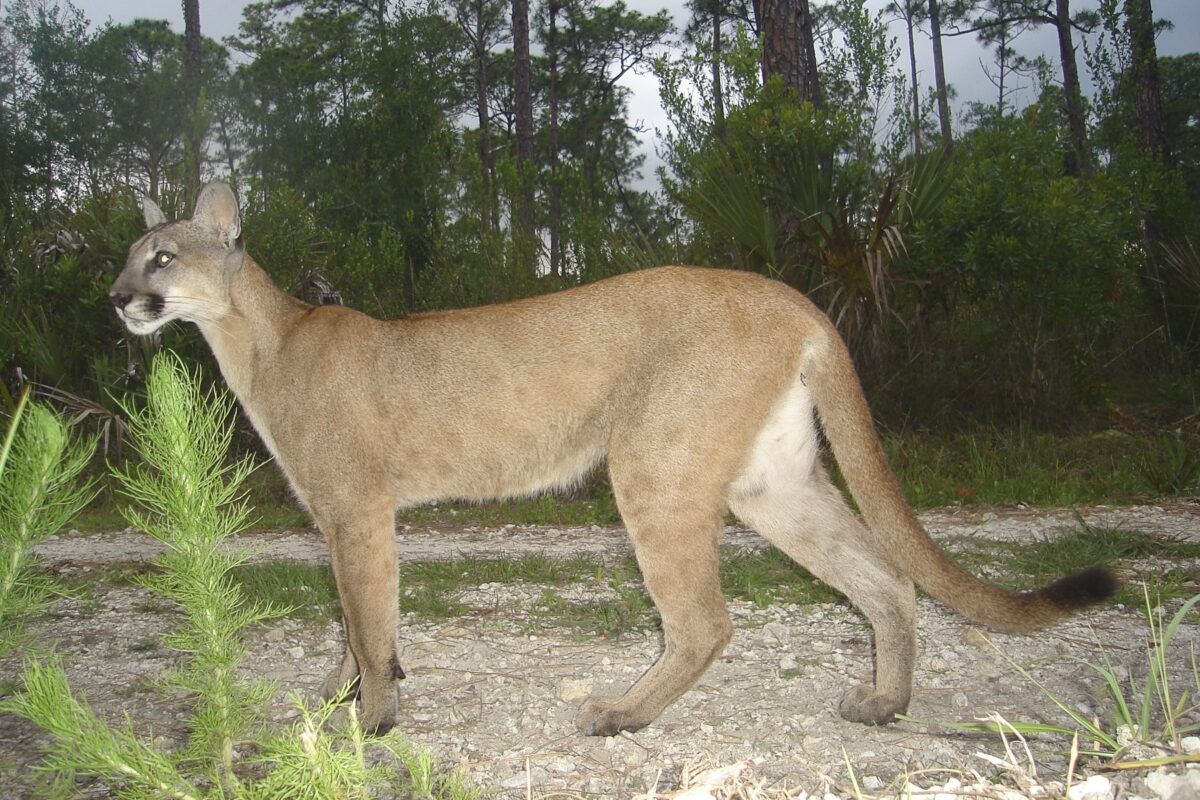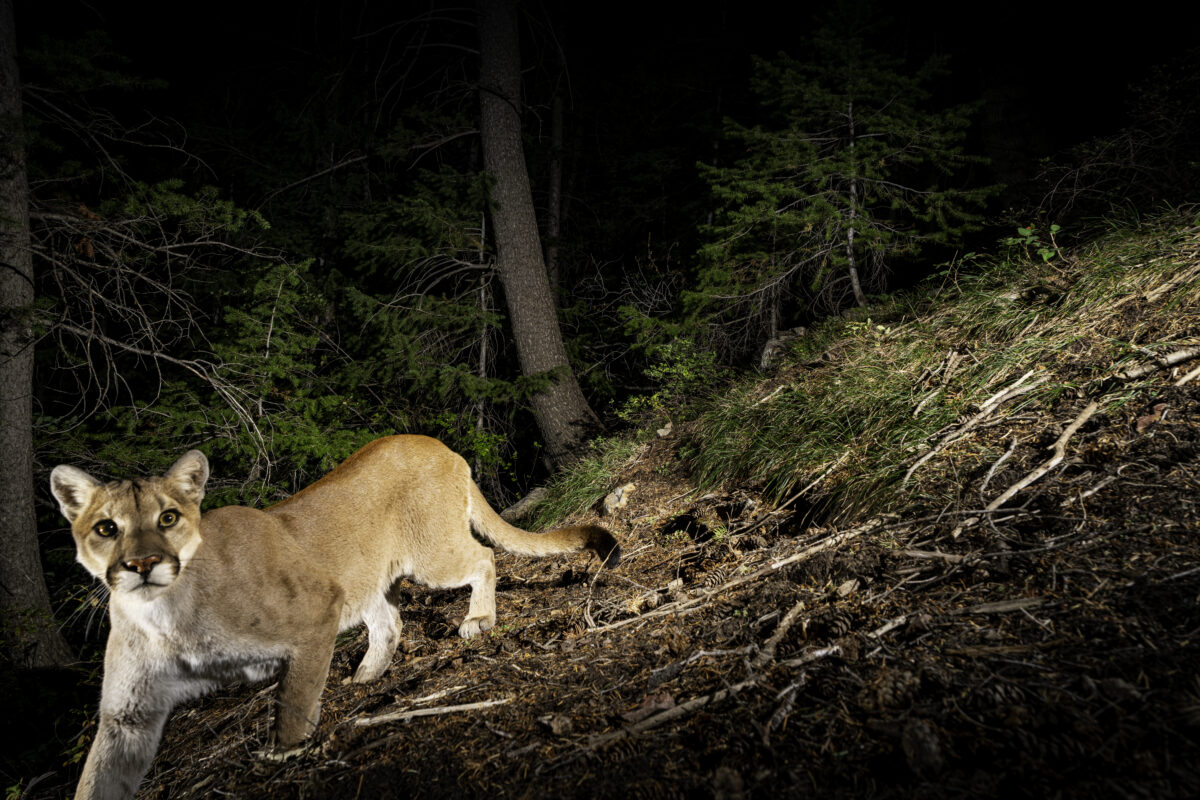Feature image courtesy of Roy Toft
By Paige Munson, Science and Policy Coordinator
Hunters have long used teams of dogs to chase mountain lions. One well known description comes from former president Theodore Roosevelt:
With a very little training, hounds readily and eagerly pursue the cougar, showing in this kind of chase none of the fear and disgust they are so prone to exhibit when put on the trail of the certainly no more dangerous wolf. The cougar, when the hounds are on its track, at first runs, but when hard-pressed takes to a tree, or possibly comes to bay in thick cover. (Roosevelt, 1922)
Today, dogs are still used for mountain lion hunting, and also for research. Now, more and more people are asking whether dogs could be used to mitigate human-mountain lion conflicts in the form of hazing.
Generally speaking, “hazing” refers to practices that are meant to teach animals to stay away. While hazing can be accomplished through various means, some states have already incorporated hazing with dogs as part of their policy. California, for instance, allows for “aggressive hazing that does NOT injure or kill the mountain lion. The use of less than lethal ammunition (beanbags, rubber bullets, cracker shells, rock-salt, paintballs), noise making devices, pursuit with ATV, and/or pursuit with dogs” (State of California, 2022).
The practice of using dogs to haze mountain lions sparks broad debates surrounding effectiveness and ethics. Some believe it could stop livestock depredations, keep people safer, and save the lives of mountain lions that would have otherwise been killed due to conflict. Some claim that mountain lions no longer fear humans, and hazing could instill that fear. On the opposite side, some see hazing as a cruel practice that needlessly endangers wildlife and working dogs, while not doing anything to help conflict. There has been a glaring lack of research on the topic, but recent publications may help to offer some insight.
What does the research say about hazing with dogs?
In 2024, two studies were published regarding how chasing mountain lions with dogs impacts the lions’ behavior. The first study was conducted by Winter et al. (2024) in California. The team captured and collared mountain lions by chasing them with dogs or setting box traps in the area. 34 mountain lions were captured using dogs, and the other 42 were captured using traps. They measured how far the mountain lions fled from where they were captured, and if they returned to the location. Both the lions captured with dogs or in box traps fled similar distances, and neither group avoided where they were captured. They concluded that pursuit with dogs did not deter mountain lions from a specific area.

A separate study was conducted by Parsons et al. (2024) in collaboration with the Kalispel Tribe of Indians. This work was conducted in Washington State and aimed to determine if hazing mountain lions with dogs could increase mountain lions’ sensitivity to approaching humans. The researchers, who included the well-known houndsman Bart George, accomplished this by approaching GPS-collared mountain lions while playing podcasts aloud. They measured how close they could get to the mountain lion before it ran away, and how far it ran. The 12 mountain lions in the control group were only approached in this way. The 39 mountain lions in the treatment group were approached and then chased by dogs. Both groups were approached in four separate trials.
After having been hazed, mountain lions began to flee from the approaching researchers sooner. They also ran farther away than before. The control groups that weren’t chased with dogs allowed the researchers to get closer and fled a shorter distance over the course of the four trials. The researchers concluded that hazing with dogs could increase mountain lion avoidance of approaching humans, and that exposure to approaching humans with no hazing could make lions more tolerant of human approach.
Both of these studies face limitations. Winter et al. (2024) didn’t follow traditional hazing protocol and instead relied on the hazing effects of capture. Parsons et al. (2024) sampled primarily male mountain lions, which may bias the results to reflect male mountain lion behavior more so than female. Neither study tested whether or not hazing could reduce any type of conflict with mountain lions. It’s unclear whether they offer any practical lessons for human safety.
What doesn’t the research say?
Hazing mountain lions with dogs is a tool we have more questions about than we do answers. Dogs don’t appear to deter mountain lions from returning to a location after one interaction. And hazing with dogs might increase mountain lion’s avoidance of the As of now, no published research has studied if hazing could be used to mitigate mountain lion conflict with livestock or people. Also, research is still needed on whether hazing with hounds has short- or long-term impacts on the individual lions’ well-being.
The research also doesn’t address whether the effects of hazing last for very long—whatever those effects may be. As of now, the methods needed to haze mountain lions with dogs, what goals it could accomplish, and how long the effects will last are unknown.
Do mountain lions need more fear?
Some believe that mountain lions have lost their fear of humans, and that hazing is needed to instill it once again. But is there any reason to believe mountain lions have lost that fear?
For many years mountain lion populations were persecuted as vermin, resulting in their local extinction in much of the United States. New protections in the mid 20th century helped populations recover in many areas. Today, there are many claims that there are more mountain lions than there used to be before, and in many locations across the American West, that is true. However, this conservation success does not mean that lions are overpopulated — far from it.
With more mountain lions, an expanding wildland-urban interface, social media, and ubiquitous outdoor cameras, we are able to see lions more than ever before. This increased exposure has led many to believe that mountain lions no longer fear people, and that hunting or hazing is needed to teach them more fear. But mountain lions avoid and hide from people every day. They become more nocturnal, change where they live, and reduce their activity to avoid people (Bolas, et al., 2024 and Riley, et al., 2024). Current evidence suggests that mountain lions still have a strong avoidance of humans, with or without hazing.
Conclusion
Hazing may have the potential to help protect or harm mountain lions. If hazing does have a place in mitigating human conflict with lions, it could offer an alternative to killing the lion involved in the conflict. However, if the method is ineffective at reducing conflict, it may just offer a pathway for individuals to harass mountain lions. Furthermore, we don’t fully understand the potential damage that hazing could cause to mountain lions. There is also a question regarding how safe it is to deploy dog teams to chase mountain lions in areas with human-mountain lion conflicts — most of which occur near human homes.
Without more research, it is difficult to determine whether or not such a practice should have a place in mountain lion coexistence strategies. Fortunately, there are many other nonlethal tools to address coexistence with large carnivores. Current evidence supports the use of nonlethal methods to coexist with large carnivores as the most effective and sustainable approach (Lorand, et al., 2022). Here at the Mountain Lion Foundation, we will continue to support nonlethal coexistence strategies that protect both lions and the people living with them.
References
Bolas, E. C, Pingatore, A.D, Mathur, M, Blumstein, D. T, Sikich, J. A, Smith, J. A., Benson, J. F, Riley, S. P.D, & Rachel V. Blakey, R. V. (2024) Human recreation influences activity of a large carnivore in an urban landscape, Biological Conservation, Volume 301,10812. Retrieved from: https://www.sciencedirect.com/science/article/pii/S0006320724003744?via%3Dihub
Lorand, C., Robert, A., Gastineau, A., Mihoub, J. B., & Bessa-Gomes, C. (2022). Effectiveness of interventions for managing human-large carnivore conflicts worldwide: Scare them off, don’t remove them. The Science of the total environment, 838(Pt 2), 156195. Retrieved from: https://doi.org/10.1016/j.scitotenv.2022.156195
Parsons, M. A, George, B. E, & Young, J. K. (2024). Evaluating the efficacy of aversive conditioning of mountain lions with hounds. Canadian Wildlife Biology and Management, 13(2). Retrieved from: https://cwbm.ca/evaluating-the-efficacy-of-aversive-conditioning-of-mountain-lions-with-hounds/
Report to the Fish and Game Commission regarding findings of necropsies on mountain lions taken under depredation permits in 2021. (2024) State of California Natural Resource Agency: Department of Fish and Wildlife. Prepared. Wildlife Health Laboratory. Retrieved from: https://nrm.dfg.ca.gov/FileHandler.ashx?DocumentID=198919&inline
Riley, S. P. D., Sikich, J. A., & Benson, J. F. (2021). Big cats in the big city: Spatial ecology of mountain lions in Greater Los Angeles. The Journal of Wildlife Management, 85(8), 1527–1542. Retrieved from: https://www.jstor.org/stable/27088093
Roosevelt, T. (1922) The Wilderness Hunter. [New York, London, G.P. Putnam’s Sons [Pdf] Retrieved from the Library of Congress, https://www.loc.gov/item/26014771/.
Winter, S. Y, Van Vuren, D. H, Vickers, T. W, & Dellinger, J. A. (2024). Response of mountain lions to hazing: Does exposure to dogs result in displacement? Proceedings of the Vertebrate Pest Conference, 31. Retrieved from: https://escholarship.org/uc/item/8hm0k87f



 Facebook
Facebook Twitter
Twitter Send Email
Send Email


